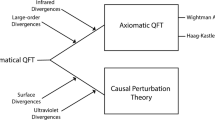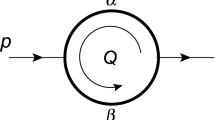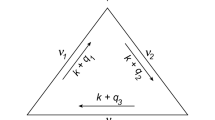Summary
A new definition of integral is proposed, which is based on a direct generalization of the standard Darboux sums; the new integral reduces to the ordinary one whenever the latter exists, to the partie-finie integral introduced by Hadamard (and later defined, equivalently, by many other authors,e.g. through methods of analytic regularization) otherwise. Our integral, for which we deem appropriate to retain the name of finite-part integral, must be defined for each specific class of singular integrands to be dealt with; this is sufficient to cope with all physical situations of interest,e.g. motion in general relativity, or ultraviolet divergences in quantum field theories; general criteria for doing so are indicated. The aim of this work is twofold: to provide the basis for a generalized, « quasi-local » theory of integration, and at the same time to supply an effective tool for actual use on the computer. For the latter reason, only the Riemann integral is considered in our generalization, Lebesgue integration being unfit for computer use (although theoretically better suited for the application of our concepts). The presentation is oriented mainly toward application; some discourses are kept on purpose at an intuitive level, to avoid the burden of complete formal treatments, which will be reported elsewhere.
Riassunto
Si propone una nuova definizione dell’operazione di integrazione, fondata su una generalizzazione della ordinaria somma di Darboux; il nuovo integrale si riduce a quello ordinario ogni qualvolta questo esista, all’integrale a parte finita introdotto da Hadamard (e definito in seguito da molti altri autori in modo equivalente, ad esempio con metodi di regolarizzazione analitica) altrimenti. Il nostro integrale, per il quale riteniamo appropriato conservare il nome di « integrale a parte finita », deve essere definito specificamente per ciascuna classe di integrandi singolari da trattarsi; ciò è sufficiente in tutti i casi di interesse fisico, ad esempio moto in relatività generale o divergenze ultraviolette in teorie quantistiche di campo; si indicano criteri generali per raggiungere tale scopo. Lo scopo del presente lavoro è duplice: porre le basi per una teoria generalizzata, « quali locale » dell’integrazione, ed insieme fornire un concreto algoritmo per il calcolo numerico. Per questa seconda ragione si considera solo l’integrale di Riemann, essendo quello di Lebesgue benché teoricamente più idoneo, inutilizzabile nel calcolo elettronico. La presentazione è orientata soprattutto alle applicazioni: diversi argomenti sono trattati di proposito in modo intuitivo, per evitare il gravame di trattazioni formali complete, che saranno riportate in altra sede.
Реэюме
Предлагается новое определение интеграла, которое основано на непосредственном обобшении стандартных сумм Дарбу; новый интеграл сводится к обычному интеграду тогда, когда последний сушествует, или в противном случае к интегралу «конечной части», введенному Адамаром (и эатем определенному многими авторами зквивалентным обраэом, например, череэ методы аналитической регуляриэации). Нащ интеграл, для которого мы считаем уместным сохранить наэвание интеграла «конечной части", должен быть определен для каждого спе-циального класса рассмотренных сингулярных подынтегральных выражений. Этого окаэывается достасочно для того, чтобы охватить все интересные фиэические ситуации, например, движение в обшей теории относительности или ультрафиоле-товые расходимости в квантовых теориях поля. Укаэываются обшие критерии для осушествления предложенного метода. Цель зтой работы двойная: с одной стороны, обеспечить основу для обобшенной «кваэи-локальной» теории интегрирования, а с другой стороны, соэдать зффективный метод для реального испольэования на вычислительной мащине. По последней причине рассматривается только интеграл Римана в нащем обобшении, причем, интегрирование Лебега непригодно для исполь-эования в вычислительных мащинах (хотя зто интегрирование теоретически более удобно для применения нащих концепций). Иэложение приспособлено для непос-редственного испольэования; позтому некоторые рассуждения проводятся на интуи-тивном уровне, чтобы иэбежать тяжести полностью формальной трактовки, которая будет приведена в другом месте.
Similar content being viewed by others
References
J. Hadamard:Lectures on Cauchy’s Problem in Linear Partial Differential Equations, (London, 1922).
Cf. among many others:M. Rierz:Acta Math.,81 (1949);I. M. Gel’fand andG. E. Shilov:Generalized Functions (New York, 1964);E. R. Speer:Journ. Math. Phys.,9, 1404 (1968);F. Guerra andM. Marinaro:Nuovo Cimento,60 A, 756 (1969);F. Guerra:Nuovo Cimento, 1 A, 523 (1971). For work done by the author and his collaborators since 1953, see ref. (3).
E. R. Caianiello:Combinatorics and Renormalization in Quantum Field Theory, in press.
E. R. Caianiello:Colloque sur les problèmes mathématiques de la théorie quantique des champs, Lille, June 1957.
L. Infeld andJ. Plebanski:Motion and Relativity (Warszawa, 1960).
Author information
Authors and Affiliations
Additional information
To speed up publication, the author of this paper has agreed to not receive the proofs for correction.
Research performed for the most part while guest of the Mathematical Sciences Department, IBM Watson Research Center, Yorktown Heights, N. Y.
Rights and permissions
About this article
Cite this article
Caianiello, E.R. Generalized integration procedure for divergent integrals. Nuov Cim A 15, 145–161 (1973). https://doi.org/10.1007/BF02822891
Received:
Published:
Issue Date:
DOI: https://doi.org/10.1007/BF02822891




